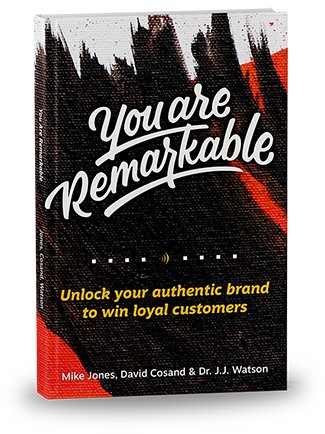The Nike Swoosh.
The Golden Arches.
The Instagram camera.
If you stop and think about it, you’d probably find that many of the big name brands you see, or interact with everyday have one thing in common—or rather, the lack of one thing. Each one has an iconic, letterless brand logo. Or to use another branding term, you can recognize Nike, McDonald’s and Instagram (to name a few) with their symbol, a pictorial logo with no brand name, no text, and not a single letter from the alphabet.
Why do letterless brand logos work?
What gives a non-letter brandmark its staying power in our minds?
More importantly, if your brand or company is itching for a new logo and thinking of going letterless, would a pictorial logo be the best fit? Would it help define your brand’s position and connect with your audience? Or would it confuse your existing audience and muddle your message?
Like any aspect of brand expression, the answer’s in the details. With or without letters, logos come with variables. What might work best for one brand may not work so well for another… and with a few pros and cons you can probably navigate your own situation.
Letterless Pros
If you think about it, and provided you’re putting effort and resources into your brand development, there’s some great reasons to go with a non-letter brandmark (or more aptly, a ‘logomark’). In many cases, showcasing a letterless logomark amplifies your brand’s positioning, iconic quality, distinctiveness, and memory.
Here’s how that breaks down:
Positioning
A logomark brings great potential.
A clean, bold logo with no letters can build upon, and even leverage a brand’s unique positioning. It does this by bringing in another concept beyond your name to help define, and in no unclear terms, show your brand to the world.
This is especially helpful for brands that are built on ‘invented’ names (ones with no intrinsic meaning in the words, or no obvious connection to founders’ names.) These kinds of brand names don’t create any unique positioning on their own and so a pictorial symbol can help demonstrate the brand’s position, message, and personality.
Iconic Quality
The biggest pro of logomarks might be fleshing out your brands’ iconic quality—while raising everything to an iconic status.
This especially happens when the logo demonstrates the brand’s unique position. It actually is an icon and therefore can become an iconic mark to stand in place of the name. Again, think of Nike’s Swoosh, or of Apple’s apple icon. Their logomarks have become so ubiquitous that they no longer display the name with the logomark.
The mark has become the symbol for the brand.
Distinctiveness
It’s generally easier to design a distinct logomark that does not contain a letter if only because there are so many more options available. With English letters there are only 26 baseline options (maybe 52 if you differentiate capitals from lowercase). With images and symbols you have exponentially more directions to work with, increasing your ability to create a distinctly different mark for the brand.
Memory
Generally, people have a much easier time remembering unique and distinct shapes than they do a name, or even a single letter.
This ties to my previous point—that a symbol can be more distinct than a letter. Keep in mind that an unknown symbol presents people with a mental puzzle (essentially a connection-making device) to be solved. If the logomark is clear, distinct, and of course, solvable, it increases the likelihood people will remember the symbol and its association with the brand.
A puzzle we’ve solved, especially if it’s neat and simple, sticks in our memory.
The Cons of Going Letterless
Logomarks, rather than a logo with initials, a brand name, or even a text-image combination like an old school emblem, comes with their own liabilities.
Here’s a few.
Connecting the logomark to the name takes work
That’s because a lettermark, (a logo with the brand name, or a brand’s letters) comes out of the gate with a tighter association with the name. Early on, and for those already familiar with the brand, it’s less work establishing the logo with the name.
Suppose your firm name is “Miller and Sons,” then going with an “M” makes a lot of sense. It doesn’t require a lot of thinking and doesn’t raise any questions as to ‘why that mark?’ That being said, and unlike a bold logomark, it may not create as much interest. Without a puzzle to solve, there’s less memory potential.
Most logomarks need to be used often with the full name of the brand to demonstrate the connection between the two. Then over time, they can be split apart and often the logomark will become the primary logo for the brand down the road. For an example of this, think of Starbucks and their mermaid emblem—name and logo used to be very tightly integrated, while now they are almost never used together.
A natural progression for a brand you’ll sometimes see twice on the same street.
Harder to approve
When it comes to that stamp of stakeholder approval, Logomarks can be a hard sell.
Because lettermarks are generally less abstract than a brand’s name, they are easier to approve. This proves true if there are a lot of decision-makers required to approve the new logo. Letterless logomarks are more abstract and will require some level of education and connection-making for decision-makers to ‘get it’ and get behind it.
Harder to develop
Greater rewards mean greater time and effort up front.
Because of the exponentially greater number of options with the symbol of a logomark (compared to a lettermark), a process that can dive deeply and surface lots of options to narrow down is more or less required. Especially when one of those abstract, letterless options will show your brand, display its values, and communicate personality to the entire world.
In other words, without letters, there’s a lot at stake.
If your brand logo-crafting process is shallow (or you only have the time and money for a few ideas up front) you’ll risk drawing from cliche ideas that probably derive from other, well-established brands. A shallow branding process can result in a logomark that doesn’t represent the positioning of the brand… and if positioning hasn’t been well defined or isn’t unique, the logomark will inherently represent that shortcoming.
This means producing a logomark that serves as a strong, unique, and interesting symbol for the brand takes time, trial and error, and at the very least a solid branding process. Lettermarks are inherently easier, as there generally are fewer options and less need to rely on the positioning of the brand when it comes to concept and design.
However you logo…
Remember that you’ve got a lot to offer.
Your organization is remarkable, and both traditional, lettered logos and letterless logomarks can show that remarkable nature to the world. But you have to know that, and own it, in order to make a brand logo people will resonate with.
Our experience helping B2B companies build websites, logos, and digital brand experiences teaches us that there’s no way to ignore the stampede.



